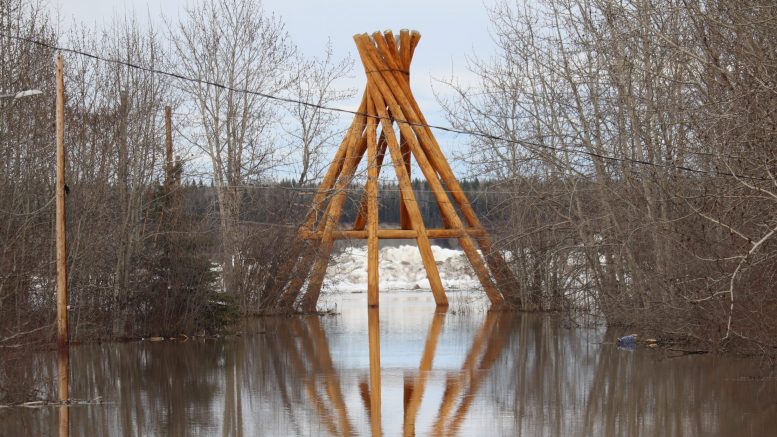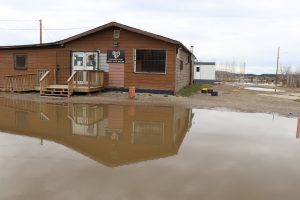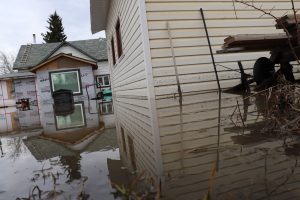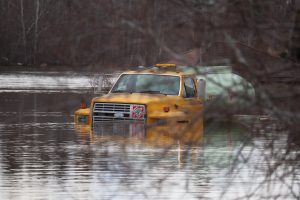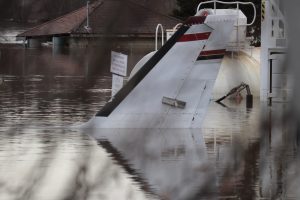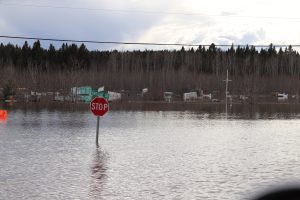It’s a cold grey morning in “tent city”, Wally Antoine is making rounds ensuring about 100 displaced Fort Simpson residents have everything they need.
“Getting coffee, refuelling the generator, checking the oil and just seeing how people are doing”: an average day for him at the camp. “People keep bringing food and I just pass it around.”
Tent city sprung up as a result of the flooding and residents being unsure where to go. Thanks to people like Antoine and countless others, they are now able to stay warm and safe as the community figures out its next steps.
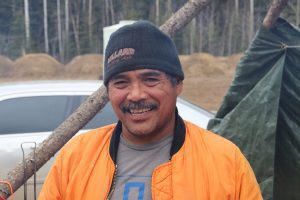
Wally Antoine is one the people ensuring everyone in tent city is safe and comfortable. (Photo by Luke Carroll/ CKLB.)
Antoine has a whiteboard and marker set up by a central canvas tent where people can write down what they need and he can help distribute it.
As we speak, he makes it clear he isn’t the only one ensuring the camp is functioning, giving credit to people like Jim Antoine, Larry Campbell, Morris Norwegian, and several others for chopping wood and bringing supplies.
He also gave thanks to the many organizations like the Northern Store, Unity Convenience Store, and Weaver & Devore Trading Ltd.
Antoine says he learned how to live on-the-land from his various friends and family in Wrigley.
“My uncles taught me a lot,” he explains, including the importance of helping others.
Tent city on a hill
Tent city is a collection of canvas tents located on the high ground of Fort Simpson.

Tent city consists around 40 canvas tents. Some residents are sleeping in their vehicles. Porta potty’s and water tanks have been set up as well. (Photo by Luke Carroll/ CKLB.)
Although the situation is stressful, the majority seem positive, keeping each other company and enjoying the camaraderie around fire pits.
And everyone had good things to say about Wally.
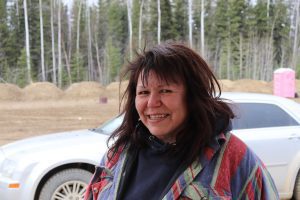
Shirley Bonnetrouge says the experience has allowed her to get to know her fellow community members. She says it has also brought her closer to her dog, Killer. (Photo by Luke Carroll/ CKLB.)
“When I first came to camp, I didn’t really know anybody,” says Shirley Bonnetrouge, adding he helped her get established.
She is huddled with a group around a fire for breakfast Thursday morning.
“They kind of adopted me,” she says. “I come over every morning for coffee and sit around all day.”
Bonnetrouge’s small dog, Killer, lays in his crate a few meters away and she says the experience has brought her closer to her pet.
Denise Noel, her husband Donald and several friends refer to their area of tent city as Manhattan. But they say their experience in the upper east side wouldn’t be nearly as pleasant without the help of Antoine.
“Wally here, personally, has looked after us,” Denise says.
“He is the last one to go to bed and he’s up with coffee ready first thing in the morning,” Donald adds.
More residents are expected to arrive at the camp as the days stretch on before the community can return to their homes permanently and begin rebuilding.
Although everyone in tent city is making the best of the situation, they are all fully aware it was never Plan A.
Confusion around evacuation
The campsite came out of a situation of desperation, when 700 people were displaced from their homes for an undetermined amount of time.
“We had no intention at first at supporting an entire temp camp off the island,” says Fort Simpson Mayor Sean Whelly.
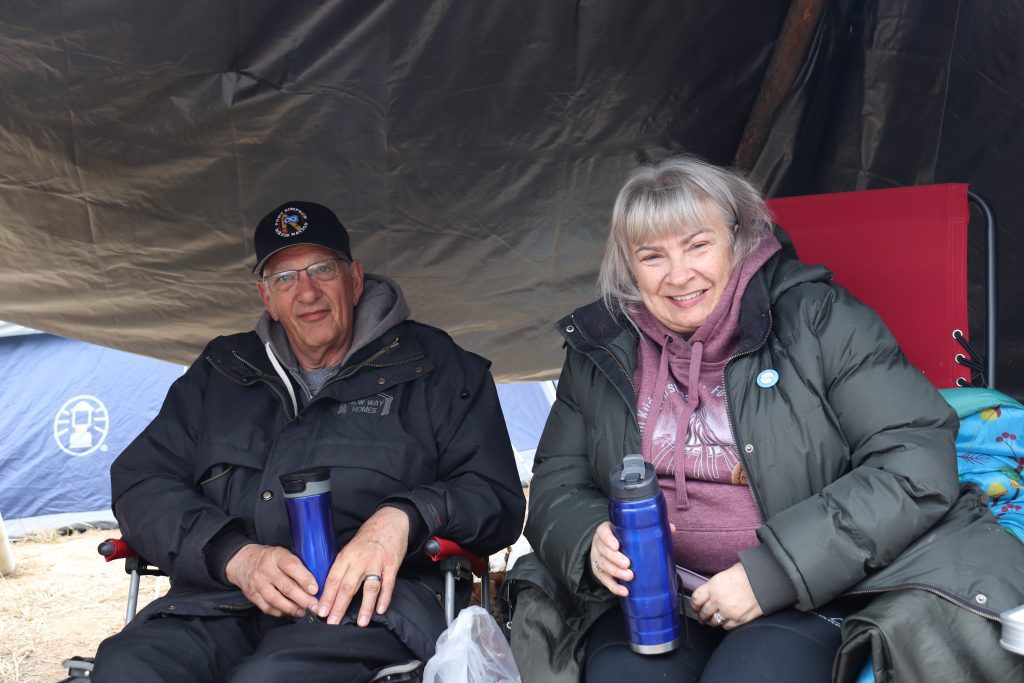
Left: Donald and Denise Noel have lived in Fort Simpson for three years. The couple say due to flooding and COVID, they will be moving back to Newfoundland to be able to see family again. (Photo by Luke Carroll/ CKLB.)
On Saturday, Fort Simpson declared a state of emergency as water levels continued to rise. By Sunday, residents on the island needed to evacuate — but there were few places to go.
“We thought that anybody that needed to get out because they didn’t have the capacity to take care of themselves would be transported to the airport and taken to Yellowknife where we knew there was lots of room,” he says.
Whelly adds he thought the plan was for residents to be put up in hotel rooms, but discovered it would actually be the field house, something he questioned.
“It created a lot of confusion,” he says.
Many residents agree, they were unsure of what the evacuation plans were when they got the order.
Yellowknife then became off limits due to the ongoing COVID-19 outbreak; other communities were also stretched thin. Hay River dealt with its own flooding and Fort Providence had already taken in the displaced residents from Jean Marie River First Nation (Tthek’éhdélı) which is also experiencing extreme flooding.
“That just throws anybody’s emergency plan into the dump,” Whelly says. “We had to make a lot of quick changes to what we were doing.”
Fort Smith was the next destination, which took in elderly residents who were in need of care — a gesture greatly appreciated by the community.
Waiting on the Deh Cho
Now the residents wait on the high ground for the Deh Cho (Mackenzie River) to make the next move as the current flooding has been caused by the Liard River.
“We know it’s going to come sooner or later,” Whelly says. “We just hope it doesn’t come while this big ice pack is in front of Fort Simpson.”
On a drive through the island, water covered entire backyards, ducks swam on the golf course, and the only hint of the downtown airport was the tail of a plane poking through the water. This was after it had receded a full foot.
The residents are restricted from entering the island as they would only have about 20 minutes to leave if the Deh Cho does start moving. Whelly explains they have a system in place where people can get an escort onto the island to see the state of their homes.
Muaz Hassan, the owner of Unity Store, says he has three properties on the island.
“One of them has a basement, I checked this morning and found I have five feet of water, so there’s going to be some damage,” he explains.
But adds luckily his store is on the high ground and was spared.
Although it hasn’t been fully scoped out, Whelly expects the damage to be extensive, but he isn’t worried about that right now.
“We’re keeping people safe and comfortable and we’re not even thinking about money,” he says, “whatever we need, we’re getting.”
A bright spot in a dark time
Back at tent city on Wednesday evening, Łı́ı́dlı̨́ı̨́ Kų́ę́ First Nation Chief Gerald Antoine gathered community members for a drum prayer.
“When we do this it’s a special recognition of ourselves,” he told the attendees under the evening sun. “We’re also expressing our appreciation to all the land has provided for us.”
The drum prayer was a way to lift people’s spirits.
“I know that we all want to go home,” he says, “but it’s not safe.”
Dehcho Grand Chief Gladys Norwegian also shared a prayer.
“We need to continue to support each other, some of us are not feeling the best,” she said, also stressing the importance of the relationship with the land.
“Water is us and we need to respect water,” she said.
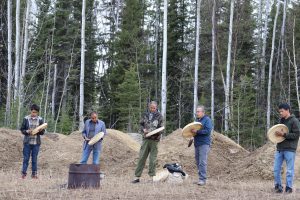
Łı́ı́dlı̨́ı̨́ Kų́ę́ First Nation Chief Gerald Antoine held a drum prayer Wednesday evening. (Photo by Luke Carroll/ CKLB.)
Grand Chief Norwegian now lives in Fort Simpson but is originally from Tthek’éhdélı.
“It depends on who you talk to, there are people that are very devastated,” she told CKLB.
But Norwegian says the experience has also shown her how kind people can be.
“The support is coming in from all over the place… They’re even sending KFC,” she says with a laugh.
After the drum prayer, Chief Antoine spoke with CKLB about how the disaster has given people a chance to focus on what’s important.
“It will help our people to really connect spiritually,” he says. “And also working together as a community.”
Chief Antoine says people are talking, listening, visiting and helping one another.
“We’re beginning to share those things with each other and it’s really good to see,” he finishes.
This includes Wally Antoine who is making his rounds after the drum prayer, making sure everyone is warm enough.
When asked about a favourite memory since being at the camp, there was no hesitation: the drum prayer.

